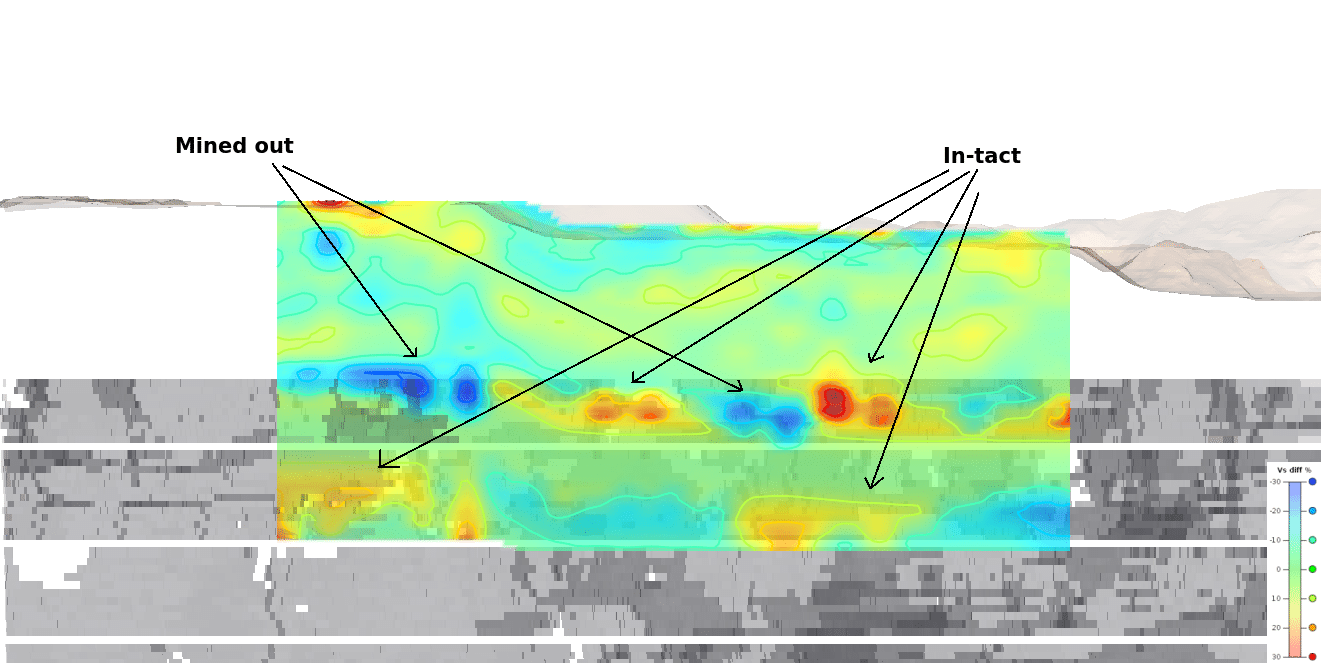Imaging
IMS has adapted Ambient Noise Tomography from crustal seismology and volcanology for use in mineral exploration and geotechnical applications.

The potential of using seismic methods for mine planning and exploration has long been known (for a review, see Malehmir et al., 2012) but, unlike the oil and gas industry, acceptance by the mining industry started only recently. As is evidenced in several studies (e.g. Pretorius et al., 2003), the overall performance of seismic methods is highly site- and geology-dependent.
The typical procedure for mineral exploration begins with geophysical surveys, followed by a drilling programme to investigate potential targets. Since the retrieved drill core samples are one-dimensional observations, many holes are required to interpolate and interpret potential deposits, which can lead to very high costs. To reduce the amount of drilling, active seismic imaging is occasionally used as an intermediary. However, the active sources (e.g. large vibrating trucks or explosive shots) are expensive and unsuitable for operation in remote or environmentally sensitive areas.
In recent years, passive seismic imaging using ambient noise has emerged as a novel, low-cost and environmentally sensitive approach to exploring the sub-surface. This technique has been used to image the sub-surface on a crustal scale (e.g. Shapiro et al., 2005; Sabra et al., 2005; Moschetti et al., 2007; Young et al., 2011; Poli et al., 2012; Lin et al., 2013) and industrial scale (e.g. Gouedard et al., 2008; Nakata et al., 2011; Olivier et al., 2015) and can even be used to image reflectors (Draganov et al., 2009). This technique dispenses with active seismic sources, and instead uses ambient seismic noise, such as ocean waves, traffic or minor earthquakes.
IMS has conducted several successful passive seismic mineral exploration surveys in Australia, North America, Europe and Africa. The results from these surveys showed how ambient noise tomography and passive seismic imaging can reduce the amount of drilling required to find and delineate new exploration targets, determine depth of cover for improved gravity corrections and give regional geological and hydrogeological information like the location and extent of faults.
References Draganov, D., Campman, X., Thorbecke, J., Verdel, A. and Wapenaar, K., 2009. Reflection images from ambient seismic noise: Geophysics, 74, A63–A67.
Gouedard, P., Roux, P. and M. Campillo, 2008. Small scale seismic inversion using surface waves extracted from noise cross-correlation: Journal of the Acoustical Society of America, 123, EL26–31.
Lin, F., Li, D., Clayton, R.W. and Hollis, D., 2013. High-resolution 3d shallow crustal structure in long beach, California: Application of ambient noise tomography on a dense seismic array: Geophysics, 78, 45–56.
Malehmir, A., Durrheim, R., Bellefleur, G., Urosevic, M., Juhlin, C., White, D.J., Milkereit, B. and Campbell, G., 2012. Seismic methods in mineral exploration and mine planning: A general overview of past and present case histories and a look into the future: Geophysics, 77, WC173–WC190.
Moschetti, M. P., Ritzwoller, M. H. and Shapiro, N., 2007. Surface wave tomography of the western United States from ambient seismic noise: Rayleigh wave group velocity maps: Geochemistry Geophysics Geosystems, 8, 10.
Nakata, N., Snieder, R., Tsuji, T., Larner, K. and Matsuoka, T., 2011. Shear wave imaging from traffic noise using seismic interferometry by cross-coherence: Geophysics, 76, SA97SA106.
Olivier, G., Brenguier, F., Campillo, M., Lynch, R. and Roux, P., 2015. Body-wave reconstruction from ambient seismic noise correlations in an underground mine: Geophysics, 80, KS11–KS25.
Poli, P., Campillo, M. and Pedersen, H., 2012. Body wave imaging of the earth’s mantle discontinuities from ambient seismic noise: Science, 338, 5.
Pretorius, C., Muller, M., Larroque, M. and Wilkins, C., 2003. A review of 16 years of hardrock seismics on the kaapvaal craton, in Hardrock seismic exploration: Society of Exploration Geophysicists, 247–268.
Sabra, K., Gerstoft, P., Roux, P., Kuperman, W. and Fehler, M., 2005. Surface wave tomography from microseisms in southern california: Geophys Res Lett, 32, L14311.
